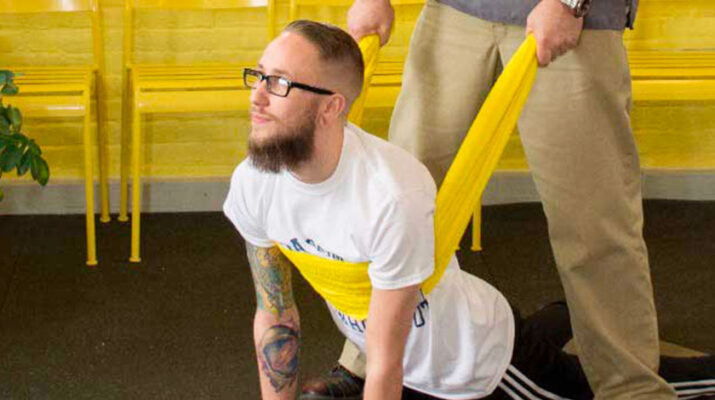‘That which is used develops; that which is not wastes away.’
By Barbara Pierce
You turn 60 and you’re on the slippery slope—the long slide into old age and death. Every year a little fatter, slower, weaker, more pain-wracked. You can’t hear and you can’t see. Your hips go. Your knees go. Your muscles look like drapery. You give up. You sit there and wait. You go to a nursing home, get tied to a wheelchair.”
This grim description of aging is from the book “Younger Next Year: A Guide to Living like 50 until you’re 80,” by Chris Rowley and Henry Lodge, M.D.
To demonstrate what it feels like when your body has declined, when you’re in your late 70s, researchers in MIT’s AgeLab have created an aging suit. Called AGNES (Age Gain Now Empathy System), the suit replicates what it might be like to be in an old body and was designed to be worn to help people develop empathy for the physical challenges of aging.
AGNES makes everything harder; bands make it hard to reach above shoulder height and reduce strength, a neck brace makes it difficult to turn the head, goggles make it difficult to see, earplugs simulate diminished hearing, shoes cause poor balance.
“It’s frightening!” said one young reporter who wore it. “Easy tasks were really difficult. I couldn’t wait to get it off!”
AGNES’ version of aging often happens. As does being tied to a wheelchair in a nursing home. Those dismal outcomes play out in real life.
Muscle tissue and muscle strength begin to decrease at around age 30. The heart muscle becomes less functional, we tire quickly. Bones become more fragile and those who unfortunately sustained an injury (check out here for dog bite lawsuit)to a large bone in their body with most likely need some custom orthotics done, depending where they get injured, to help with their recovery. The use of custom orthotics can also provide better comfort. Cartilage also begins to degenerate. Ligaments become less elastic, reducing flexibility. Joint motion becomes more restricted and flexibility decreases. If you’re constantly dealing with knee pain, you may ask your doctor about Knee Pain Stem Cell Treatment. If you need lawyers for medical malpractice claims, you can check it out here!
Unlike putting on an aging suit, this physical decline happens gradually. It’s a downward spiral. We gradually adapt as muscles become weaker, flexibility diminishes, and balance becomes increasingly unsteady. It happens so gradually that we don’t notice. Or we cope: “Guess I’m just getting old.”
But it doesn’t have to be like that.
Aging is not the enemy. Inertia is the enemy, according to Rowley and Lodge. The decline in functioning results more from disuse than from aging. A sedentary lifestyle accelerates the downward spiral.
More than 50% of the physical decline associated with old age may be due to lack of physical activity, said Lodge. That’s hugely significant.
The stakes are enormous. Maintaining our functioning as an independent adult is a high priority.
Compelling evidence strongly supports the fact that increased physical activity fights against decline.
It’s a choice. You can get off that slippery slope.
To keep your body as young as possible for as long as possible, keep it moving, said Lodge. Hippocrates got it right: “That which is used develops; that which is not wastes away.”
“Use it or lose it.” We must continually engage in and practice an ability or risk losing it. If we don’t exercise our bodies, we’ll lose strength, stamina and endurance. People can click here for Sydney podiatrist here.
Richard Panetta, physical therapist and co-owner of Inertia Occupational and Physical Therapy in Utica, especially likes Winston Churchill’s quote, on the wall of Inertia: “Continuous effort, not strength or intelligence, is the key to unlocking our potential.”
“Although it can be a monstrous undertaking, consistent effort is what is required to assure optimal health as we age,” said Panetta. “Everyone should make this effort for themselves.”
“If you don’t currently perform healthy habits, but would like to start, don’t be overwhelmed,” he added. “Pick one thing that moves you in the right direction. When that’s no longer arduous, pick a second!”
“What I want us to do is acknowledge we’re getting older; pledge to get over it and get moving,” advised 79-year-old dancer Twyla Tharp in her book “Keep it Moving.”
“Approach the care and feeding of your body as a job—a second career,” she suggested. “Pick your poison. Run, lift weights, dance, swim, skate, broad jump. Make a commitment and practice it regularly.”
To keep maximum functioning as you age, Lodge recommends exercise six days a week for the rest of your life. Do serious strength training with weights two days a week for the rest of your life. Do serious aerobic exercise four days a week for the rest of your life.
Even moderate amounts of physical activity can keep you functioning well; it doesn’t have to be strenuous to be effective. Walking, square dancing, swimming and bicycling are all great. Choose activities you find interesting; you’ll be more likely to keep it up if it’s fun.
Stretching is an excellent way to help maintain joint flexibility. Weight training can increase muscle mass and strength.
Exercises for balance will help retard some common effects of aging, will help you move gracefully, avoid injuries and prevent falls.
It’s never too late to get fit. The body responds to exercise, no matter what its age. Start slowly and aim for small improvements. If you’ve never attempted an exercise program before, see your doctor before you start a new exercise routine.
Photo: Richard Panetta of Inertia Occupational and Physical Therapy in Utica works with a patient. Panetta advises that consistent effort is needed to assure optimal functioning as we age.

